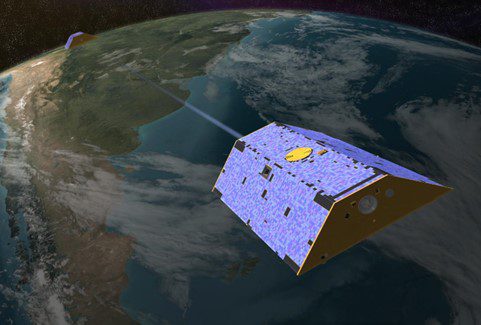Low-frequency dynamic ocean response to barometric-pressure loading
Piecuch, C. G., I. Fukumori, R. M. Ponte, M. Schindelleger, O. Wang, and M. Zhao, 2022. Low-Frequency Dynamic Ocean Response to Barometric-Pressure Loading, Journal of Physical Oceanography, 52, https://doi.org/10.1175/JPO-D-22-0090.1

Photograph shows an artist’s rendition of the twin GRACE spacecraft. Photograph courtesy of NASA (https://www.nasa.gov/feature/jpl/grace-mission-15-years-of-watching-water-on-earth).
Changes in dynamic manometric sea level ζm represent mass-related sea-level changes associated with ocean circulation and climate. We use twin model experiments to quantify magnitudes and spatiotemporal scales of ζm variability caused by barometric-pressure pa loading at long periods (≳ 1 month) and large scales (≳ 300 km) relevant to Gravity Recovery and Climate Experiment (GRACE) ocean data. Loading by pa drives basin-scale monthly ζm variability with magnitudes as large as a few cm. Largest ζm signals occur over abyssal plains, on the shelf, and in marginal seas. Correlation patterns of modeled ζm are determined by continental coasts and H/f contours (H is ocean depth and f is Coriolis parameter). On average, ζm signals forced by pa represent departures of ≲ 10% and ≲ 1% from the inverted-barometer effect ζib on monthly and annual periods, respectively. Basic magnitudes, spatial patterns, and spectral behaviors of ζm from the model are consistent with scaling arguments from barotropic potential vorticity conservation. We also compare ζm from the model driven by pa to ζm from GRACE observations. Modeled and observed ζm are significantly correlated across parts of the tropical and extratropical oceans, on shelf and slope regions, and in marginal seas. Ratios of modeled to observed ζm magnitudes are as large as ∼ 0.2 (largest in the Arctic Ocean) and qualitatively agree with analytical theory for the gain of the transfer function between ζm forced by pa and wind stress. Results demonstrate that pa loading is a secondary but nevertheless important contributor to monthly mass variability from GRACE over the ocean.
This research was funded by the National Aeronautics and Space Administration (awards 80NSSC20K0728, 80NSSC20K1241, and 80NM0018D0004) and published in the Journal of Physical Oceanography.
